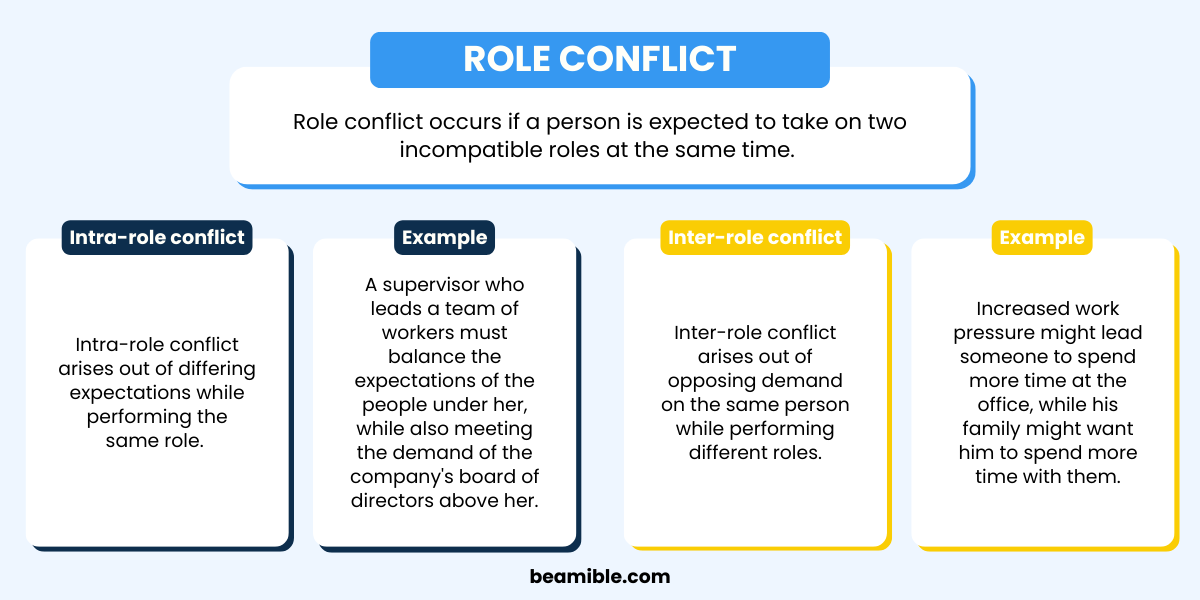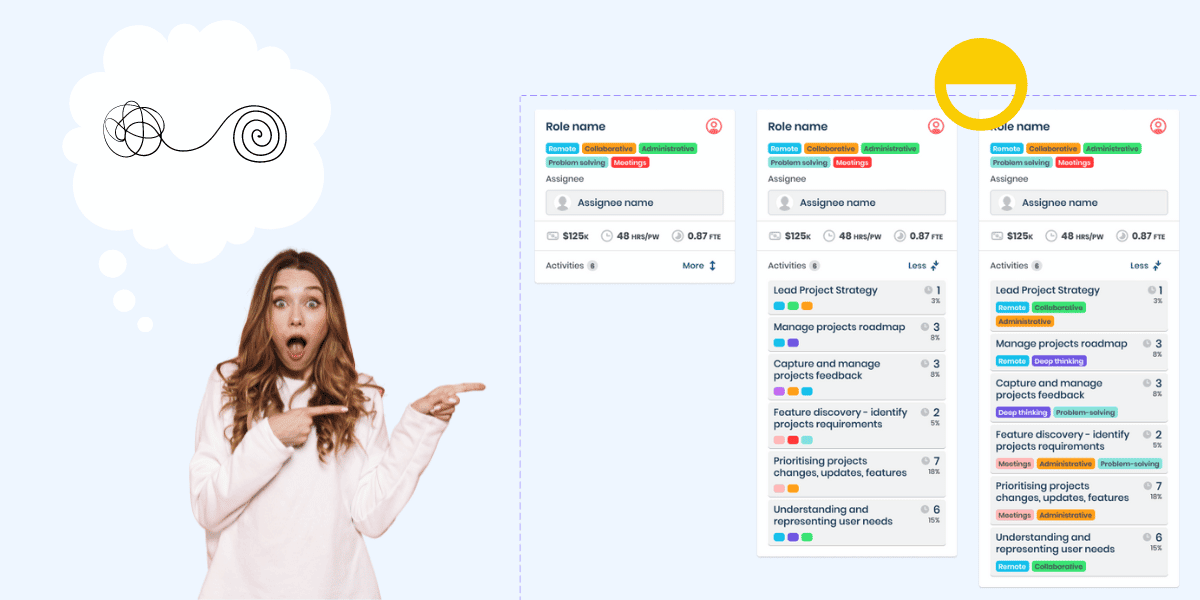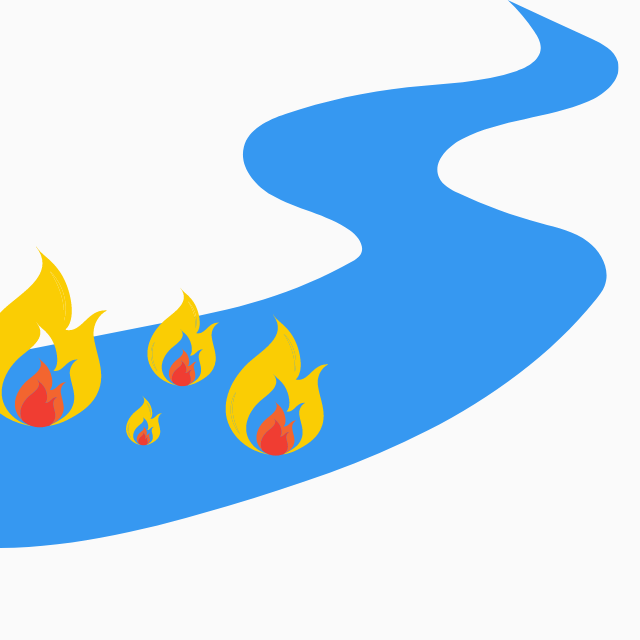Introduction
Role conflict is a pervasive issue, more so than most people might realize. The complexity of modern organizations, fluid work processes, and the rising demands of the digital economy contribute significantly to its prevalence. It’s not just a minor inconvenience or occasional source of stress; it has major implications for job satisfaction, productivity, and even mental health.
In fact, a study conducted on employees in the Banking industry concluded that role conflict is one of the most serious problems that can reduce job satisfaction and create a disharmonic workplace (1). Another similar study showed that role conflict has also been linked to emotional exhaustion, depersonalization, and turnover intention among employees (2).
Recognizing and addressing role conflict in your organization isn’t just about maintaining a harmonious work environment—it’s about protecting your team’s mental health, securing your company’s productivity, and ensuring the longevity of your organization.
Whether you’re a team leader hoping to foster a more conducive working environment, an HR professional looking to better understand the complexities of role conflict, or an employee navigating your way through the maze of responsibilities and expectations, this discussion will illuminate a crucial aspect of workplace dynamics.
Let’s delve into what role conflict is, explore a variety of its examples, and identify different types of role conflict that might be at play in your own work setting.
What is Role Conflict?
Role conflict, akin to its portrayal in the annals of organizational psychology, refers to a state where an individual’s various roles carry opposing expectations, pressures, or demands, thus causing stress and discomfort. This psychological conflict may arise within a single job role or between two or more different roles that the individual occupies.
Role conflict is not confined to professional life. It has far-reaching implications for personal life as well. The more conflicting the roles, the heavier the weight on an individual, impacting all areas of life, from personal relationships to mental health. When I face role conflict, it’s not just my productivity at work that suffers. It spills over into my family life, my social interactions, and my overall wellbeing.
Let’s picture this: You’re a team lead in a tech firm, but you’re also an avid supporter of work-life balance. However, your job often demands you to work late hours, thereby conflicting with your personal belief and causing stress. This is a simple yet accurate example of role conflict. It might seem innocuous, but when such contradictions stack up, they can have a profound impact.
Role conflict’s impact on the modern workplace is hard to underestimate. According to the Journal of Management, both role ambiguity and role conflict result in lower levels of performance since they represent a lack of information and information overload (3).
It’s clear that understanding role conflict is not a luxury but a necessity in today’s complex work dynamics. An accurate understanding helps in managing it effectively, fostering a healthier, more productive work environment, and promoting overall employee wellbeing.
What are the Common Causes and Sources of Role Conflict?
Just as a multitude of factors can influence job satisfaction and performance, several reasons can lead to role conflict in the workplace. It’s essential to understand these causes because they provide a blueprint for where to start when looking to address and prevent role conflict.
Here are the most common causes and sources of role conflict:
- Ambiguity
- Incompatible Demands
- Multiple Roles
- Role Overload
- Interpersonal Conflict
- Organizational Change
- Organizational Structure
- Lack of Communication
- Resource Allocation
Ambiguity
When job roles and expectations aren’t clearly defined, it leaves room for misunderstandings and confusion. This lack of clarity often leads to role conflict as employees struggle to navigate their responsibilities.
Incompatible Demands
Sometimes, an employee is given tasks or responsibilities that are incompatible with one another. This could be due to a lack of resources, such as time or tools, which makes fulfilling all the demands impossible, thus resulting in role conflict.
Multiple Roles
Holding multiple roles within an organization can be a significant source of role conflict. The differing expectations and responsibilities between roles can become overwhelming and cause stress.
Role Overload
This happens when the demands of a job role exceed the employee’s capacity to fulfill them. This might be due to an excessive workload, high-pressure deadlines, or responsibilities that exceed the employee’s skills or knowledge base.
Interpersonal Conflict
Conflict between colleagues, or between employees and management, can often lead to role conflict. Such conflicts can create an uncomfortable working environment and make fulfilling job responsibilities more challenging.
Organizational Change
Change is a constant in most organizations, whether it’s implementing a new process, undergoing restructuring, or introducing a new management style. However, without proper management and communication, these changes can cause confusion and conflict among roles.
Organizational Structure
In complex or hierarchical organizations, role conflicts are more likely. The layers of management and the division of labor can create confusion about roles and responsibilities.
Lack of Communication
Poor communication within an organization can lead to role conflicts. If employees aren’t aware of changes, updates, or important information related to their roles, they may struggle to meet expectations.
Resource Allocation
Inadequate allocation of resources, such as manpower, tools, or time, can cause role conflict. Without the necessary resources, employees may find it difficult to meet their role expectations.
Understanding these causes is the first step to addressing and preventing role conflict in the workplace. Once these sources are recognized, steps can be taken to mitigate their effects, leading to a healthier, more productive work environment.
Different types of Role Conflict

Just like there are various sources and causes of role conflict, there are also different types of role conflict that individuals may experience. Understanding these types can help you identify and address the specific kind of conflict that’s present in your own situation.
Here are four primary types of role conflict:
Inter-role Conflict
Inter-role conflict occurs when the expectations of one role an individual plays conflict with the expectations of another role. For instance, the role of a parent might conflict with the role of a professional. As a working parent, you may find yourself torn between meeting a work deadline and attending your child’s school event. These opposing expectations from different roles can create stress and lead to role conflict.
Intra-role Conflict
Intra-role conflict happens when there are conflicting expectations within a single role. This could be due to different people associated with that role having different expectations. For example, as a team leader, your manager may expect you to push your team for higher productivity, while your team members expect you to advocate for their wellbeing and work-life balance. These contradictory expectations within the same role create intra-role conflict.
Person-role Conflict
Person-role conflict arises when an individual’s personal values, beliefs, or interests conflict with their role’s expectations. For example, if you strongly believe in work-life balance, but your role demands long working hours and being available even during off-hours, you may experience person-role conflict. This type of conflict often leads to stress and dissatisfaction as it forces you to act against your personal values or beliefs.
Role Overload
Role overload occurs when the expectations or demands of a role exceed the individual’s capacity to meet them. This could be due to an excessive workload, high-pressure deadlines, or lack of necessary resources. Role overload can lead to burnout, stress, and a decrease in job satisfaction and performance.
Understanding these types of role conflict can be extremely helpful in identifying the kind of role conflict you or your team members might be facing. Moreover, knowing the specific type of conflict can guide effective solutions and interventions to reduce stress and enhance job satisfaction.

Examples of Role Conflict
To help illustrate the concept and types of role conflict, let’s delve into some practical examples. These examples are designed to make the abstract concept more concrete, allowing you to better recognize and understand role conflict in your own workplace.
1. Inter-role Conflict: The Working Parent
Consider the classic example of the working parent. You’re dedicated to your role as a marketing executive, but you’re also devoted to your role as a parent. Your job requires you to work late, attend client dinners, and occasionally travel for business meetings. However, your role as a parent involves attending your child’s school events, preparing dinner for the family, and helping with homework. These conflicting expectations from two different roles cause inter-role conflict. It’s a common situation that many working parents find themselves navigating.
2. Intra-role Conflict: The Team Leader
As a team leader, you have a unique role that interfaces between management and your team. The management expects you to enforce company policies strictly, pushing your team to meet challenging targets. At the same time, your team expects you to be understanding, advocate for their needs, and provide them with support. The contradictory expectations within the same role create intra-role conflict.
3. Person-role Conflict: The Environmentally-Conscious Engineer
Imagine being an engineer in an oil company, but you’re also deeply concerned about environmental conservation. Your role demands you to work on projects that might negatively impact the environment, while your personal belief urges you to protect and conserve nature. This clash between personal values and role expectations leads to person-role conflict.
4. Role Overload: The Overburdened Employee
You’re an employee in a small start-up, wearing multiple hats. You’re handling tasks beyond your job description, working beyond regular hours, and facing high-pressure deadlines. The excessive demands and expectations of your role exceed your capacity to fulfill them, causing role overload.
Recognizing these examples in your own life can be the first step in understanding role conflict. Identifying and acknowledging role conflict can then lead to better management strategies, enhancing job satisfaction, and improving overall workplace dynamics.
Impact and Consequences of Role Conflict
Role conflict, if left unaddressed, can have significant impacts on individuals and organizations alike. Understanding these potential impacts and consequences can help underscore the importance of recognizing and addressing role conflict.
On Individuals
The impact of role conflict on individuals tends to be multifaceted, touching various aspects of their professional and personal lives:
1. Stress and Burnout
Role conflict often leads to increased stress, as individuals struggle to meet incompatible expectations. Over time, this increased stress can lead to burnout, characterized by feelings of exhaustion, cynicism, and reduced professional efficacy.
2. Reduced Job Satisfaction and Motivation
Role conflict can diminish job satisfaction as employees feel torn between conflicting demands or values. This decrease in satisfaction can subsequently lead to reduced motivation, impacting productivity and overall performance.
3. Negative Impact on Mental and Physical Well-being
The stress and strain associated with role conflict can have detrimental effects on mental health, leading to issues like anxiety and depression. It can also impact physical health, leading to problems such as sleep disorders, cardiovascular issues, or weakened immune system.
4. Strained Interpersonal Relationships
Role conflict can strain relationships with colleagues, supervisors, or subordinates, as the individual grapples with the conflicting demands of their role. This can lead to a decrease in teamwork and collaboration, negatively impacting the work environment.
On Organizations
Role conflict doesn’t only affect individuals—it can also have serious consequences for organizations:
1. Decreased Productivity
With decreased motivation and increased stress levels, productivity is likely to suffer. Employees grappling with role conflict may struggle to perform their tasks efficiently, leading to lower output.
2. Increased Employee Turnover
As job satisfaction decreases and stress increases, employees may start seeking opportunities elsewhere. High turnover can lead to significant costs for the organization in terms of recruitment, training, and the loss of institutional knowledge.
3. Lowered Morale
Role conflict can contribute to a decline in team morale. As individuals struggle with their roles, it can create a tense and stressful work environment, impacting the morale and cohesion of the entire team.
4. Damaged Reputation
If role conflict is pervasive and leads to high turnover, it can harm an organization’s reputation, making it harder to attract top talent and potentially impacting customer perception.
By understanding these impacts and consequences, we can better appreciate the importance of addressing role conflict. It’s not just about improving the work experience for individual employees—it’s also about maintaining the health and success of the entire organization.

Strategies for Managing Role Conflict
Addressing role conflict is crucial for maintaining a productive, positive work environment and ensuring employee well-being. Here are several strategies organizations can employ to manage role conflict effectively:
1. Clarify Roles and Expectations
Uncertainty and ambiguity can often lead to role conflict. By clearly defining roles and expectations, organizations can eliminate a lot of confusion. This includes clarifying the duties and responsibilities associated with each role, the performance standards expected, and who the role reports to. Regularly revisiting and updating these definitions using work design and role design principles can also help as roles evolve over time.
2. Encourage Open Communication
Organizations should foster an open and transparent communication culture. This allows employees to voice their concerns, ask for clarification, and discuss potential conflicts. Regular meetings, feedback sessions, and an open-door policy can help facilitate this.
3. Provide Adequate Resources
Role overload can be a significant source of role conflict. To avoid this, organizations need to ensure that they’re providing adequate resources - this could be in terms of staff, time, tools, or training. Regularly assessing and addressing resource needs can go a long way in preventing role conflict.
4. Support Work-Life Balance
As inter-role conflict often stems from the competing demands of work and personal life, organizations should aim to support work-life balance. This could be through flexible work culture, remote work opportunities, or wellness programs.
5. Implement Conflict Resolution Strategies
Despite best efforts, some role conflict will inevitably arise. Organizations should have strategies in place to manage these conflicts when they do occur. This could include conflict resolution training, mediation services, or policies for managing conflict.
By implementing these strategies, organizations can mitigate the impacts of role conflict, leading to more satisfied, engaged employees, and a more productive, harmonious workplace.
Final Thoughts
Role conflict is an issue that touches almost every workplace and every role, with far-reaching effects on both individuals and organizations. Understanding what role conflict is, its various types, examples, and causes is the first step in effectively addressing and managing it.
The impacts of role conflict are significant, with consequences ranging from decreased job satisfaction and productivity to increased stress and turnover. However, by implementing strategies such as clarifying roles and expectations, promoting open communication, providing adequate resources, and supporting work-life balance, organizations can greatly reduce these impacts.
Dealing with role conflict isn’t just about mitigating its negative effects; it’s about creating a more positive, productive work environment where employees feel valued, satisfied, and able to perform at their best. Don’t underestimate the power of work design for addressing several of these changes in the workplace. It’s about building a workplace culture that values clarity, communication, balance, and effective conflict resolution.
To further help in managing role conflict and promoting a more harmonious and efficient workplace, consider Beamible. Our platform is designed to help businesses better understand and manage the distribution of work, ensuring a balanced workload and clear role expectations (amongst many other things!). With Beamible, you can take a proactive approach to managing role conflict, enhancing your workplace culture and productivity.
Curious how Beamible can help mitigate role conflict in your organization and promote a healthier work culture? Talk to our sales team.
As we continue to explore and understand role conflict, we open up opportunities for better workplace experiences, greater job satisfaction, and overall organizational success. So, let’s keep the conversation going, and continue striving for workplaces that acknowledge, understand, and effectively manage role conflict.
References:
- Koustelios, A., Gkolia, A., Gkolia, A., Aspridis, G., Varsanis, K., Varsanis, K. (2115). Can Role Conflict and Autonomy Make Employees In The Greek Banking Organization Satisfied And Productive?. IJSIM. https://doi.org/10.15556/ijsim.02.03.003
- Wen, B., Zhou, X., Hu, Y., Zhang, X. (2020). Role Stress and Turnover Intention Of Front-line Hotel Employees: The Roles Of Burnout And Service Climate. Front. Psychol., (11). https://doi.org/10.3389/fpsyg.2020.00036
- Tubre, T., Collins, J. (2000). Jackson and Schuler (1985) Revisited: A Meta-analysis Of The Relationships Between Role Ambiguity, Role Conflict, And Job Performance. Journal of Management, 1(26), 155-169. https://doi.org/10.1177/014920630002600104





